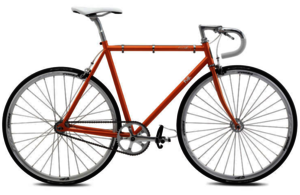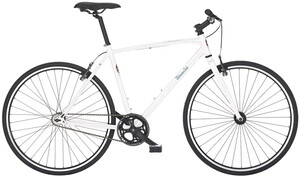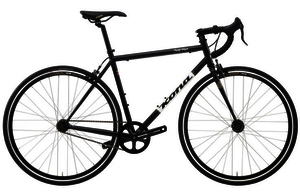One-geared bikes aren't just for cycle couriers and fashion-focused hipsters, they suit sportier commuting too.
If your commute to work is relatively flat or you are fairly fit, a bike with one gear can be as good as a bike with many gears. Possibly better. That might seem counter-intuitive. Multiple gears enable you to pedal easily uphill, downhill, into the wind, or with the wind. Singlespeeds force you to pedal at different cadences. But that's not entirely a bad thing and, other things being equal, singlespeeds are also cheaper, lighter, and more reliable.
With a singlespeed, there's less to go wrong. There are no cables to stretch, snap or suffer from friction. The chain is more tolerant of wear and irregular oiling because it runs in a straight line from one chainring to one sprocket. If anything does go wrong, it's cheap to repair. That's a big bonus for a bike that's ridden day in, day out, in all weathers, and it's probably why couriers use them. (For hipsters, it's likely the minimalist looks or the idea of elitism!)
Singlespeeds come in two varieties: freewheel and fixed-wheel. The freewheel ones, often called simply singlespeeds, have ratchets and pawls inside the chunky screw-on sprocket, so that you can coast with your feet on the pedals, just like geared bikes. A fixed-wheel uses a simple threaded sprocket. When the bike is in motion, you cannot stop pedalling. The wheel will drive the pedals around if you try, jerking you off the saddle – and possibly the bike! Don't head out into traffic on a fixed-wheel bike until you've mastered the technique.
Why would you want to forgo the ability to freewheel? It encourages you to develop a fluid, efficient pedalling cadence. It's more of a workout, if that's what you're after. And it allows better control on slippery roads, as you can slow down by back pressure on the pedals, losing speed without the risk of grabbing the wheel and sliding. In fact, it's legally permissible to ride with only a front brake on a 'fixie', so long as there's a lockring to stop the sprocket unscrewing.
Some fixed-wheel riders remove both brakes. Outside of a velodrome, this is dangerous. The front brake is what stops a bike under hard deceleration; without one, you cannot stop quickly enough. You may want to retain the rear brake too, and must do so if you ever ride the same bike with a freewheel. Many singlespeeds can be switched between either setup, thanks to a 'flip-flop' hub with a freewheel sprocket on one side and a fixed sprocket on the other. You take the wheel out and refit it. You'll need a 15mm spanner for this, and will want one in your commuter bag in case of punctures.
While a singlespeed has only one gear at a time (or two if there's a flip-flop hub and the sprockets are one or two teeth different in size), you can change that gear by changing the sprocket or chainring. The best compromise for the gear will depend on the terrain and preferred pedalling cadence. Something like 42/18 is good for hilly terrain, whereas flatter areas suit a bigger chainring or smaller sprocket, such as 42/16.
Singlespeeds in the UK are essentially road bikes or sports hybrids with a different rear frame triangle – the dropouts face to the rear so that the wheel can be pulled back to tension the chain, and they're only 120mm apart. Some fixed-wheel machines are modelled on track bikes used in velodromes: they have sharper handling and no frame fittings or clearance for: mudguards; fatter (28mm) tyres; a water bottle cage; or a rear rack. That's okay if minimalism is what you're after, but make sure the fork has a hole drilled through the crown so that you can fit at least a front brake.
Clipless pedals are a useful addition to any singlespeed, and especially fixed-wheel ones. They enable you to pedal rapidly without your feet flying off the pedals. Double sided ones are easiest to get into at the traffic lights. To orient your pedals when you set off, apply the front brake, push the handlebar forward so the back wheel comes off the road, and push the cranks into position.
Here's a few of the singlespeed bikes on the market.

Fuji Feather
Fuji's steel singlespeed is one of the better-value off-the-peg 'urban track bikes'. Style comes first, which is why it uses an old-school quill stem, a half-taped drop bar, semi-deep section rims, and a frame without any braze-ons. The rear brake uses band-on cable guides, so there's nothing to spoil the bike's clean lines if you remove it. If you want mudguards, you'll need to use Crud Roadracers or SKS Race Blades. A flip-flop rear wheel gives you a choice of 16-tooth fixed or freewheel, with a 44-tooth chainring. Note that the partially-tapped drops mean you'll be gripping cold metal when the bar-top brake levers are in reach…
£420.00
www.fujibikes.com
Bianchi Semplice
The Semplice is an unpretentious singlespeed hybrid. It's lightweight, thanks to aluminium frame and fork, but 28mm tyres give it a more forgiving ride than steel singlespeeds with skinnier tyres. Commuting essentials are easily added: there are fittings for bottles, a rear rack and mudguards. There's plenty of clearance for these as the Semplice has V-brakes rather than short-reach sidepulls. The gearing is 42/18, and most owners will likely run it with a freewheel. But there's a flip-flop hub and you could run it fixed-wheel if you wished. The pedals are folding ones, probably so that you don't bark your shins on them if you store it in a hallway.
£525.00
www.bianchi.com
Kona Paddy Wagon
Built like the fixed-wheel winter training bikes of old, the Paddy Wagon is one of the most practical drop-bar singlespeeds available. It's designed to take full-length mudguards, having frame eyelets and longer-drop sidepull brakes. Guards will even fit over the 28mm tyres specified, and tyres up to 32mm will fit if you go without guards. The fork is steel, the for 2014 the frame is a better quality chrome-moly steel, Reynolds 520. Gearing is 42/16, and fixed and freewheel sprockets are provided for the flip-flop hub. If you want a more 'urban' looking bike, Kona also offer the Paddy Wagon with a cowhorn-style TT handlebar for the same price.

Comments: